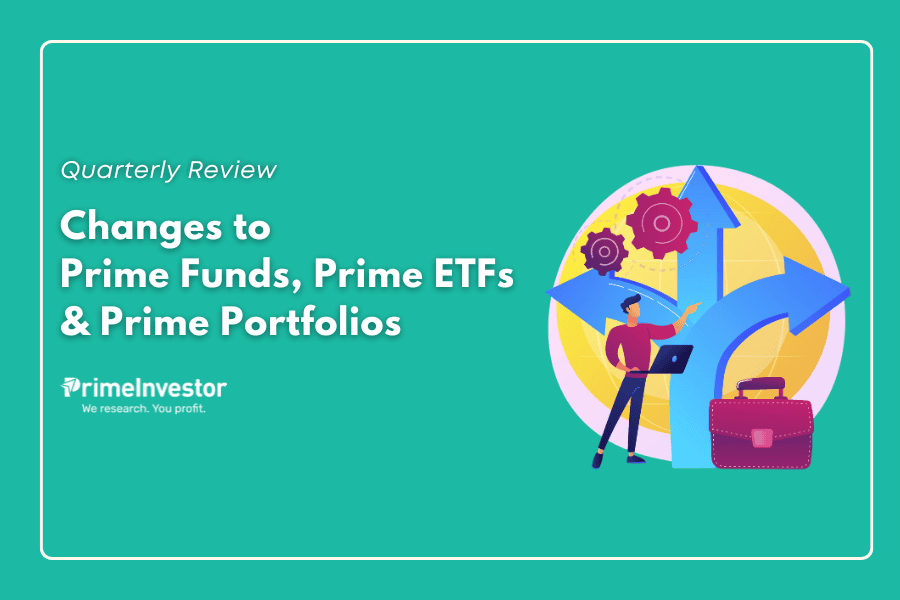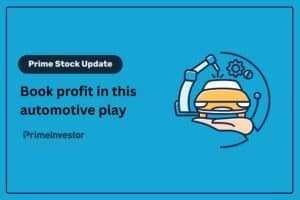Prime Funds is our list of recommendations in equity, debt, and hybrid mutual funds that are worth investing in. Prime Funds narrows down your choices from the thousands of funds that there are into a concise list of funds that span different styles. Prime Funds are selected based on performance, portfolios, and investment strategies.

In this review, we have made a few changes in multiple Prime Funds categories. Please go through the report in detail to know the changes and the rationale.
About Prime Funds
Prime Funds is our list of best mutual funds across the equity, debt, and hybrid categories. We use Prime Ratings, our fund ratings, as a first filter. We then apply qualitative analysis to arrive at our fund recommendations. Prime Funds is an enduring list of funds that you can use at any time. You will always find a fund to meet any goal you’re looking to meet.
Different categories: Prime Funds are separated into buckets, based on risk level in equity & hybrid funds and timeframe in debt funds. Each of these draws from different SEBI-defined categories. We have classified them in a more user-friendly way than using the several dozens of SEBI categories. We do not go only by Prime Ratings but look at other factors as well to narrow the list and make the choices easy for you.
Different styles: In Prime Funds, we’ve aimed at providing funds that follow different strategies for you to mix styles and diversify your portfolio with ease. The ‘Why this fund’ for each Prime Fund will brief its strategy, why we picked it, and how to use it in your portfolio.
Direct plans: We have specifically given the direct plans in Prime Funds. If you wish to know whether it is ok for you to use the regular plan of the fund, check Portfolio Review Pro periodically to know if you are with expensive regular plans.
Quarterly review: Our aim in reviewing the Prime Funds list every quarter is to ensure that we don’t miss any good opportunities that are coming up and we are not holding on to funds that are slipping. When we remove funds from the Prime Funds list, we tell you exactly what to do if you have invested in these funds. Funds we remove do not immediately call for a sell – it is just that they have slipped in performance marginally or there are better alternatives now. Unless our review tool says such funds are a ‘sell’, you can hold them (refer to our article on when to sell funds)
Using Prime Funds: You don’t need to hold every Prime Fund nor add every new fund we introduce to the list. Unless it fits your overall portfolio/strategy, or there is something lacking, there is little need for you to go on adding funds. Our idea of covering them in detail through some of our calls is to let you know the strategy, style, and suitability in different portfolios. It is not a specific call to buy right away, unless we mention that it is a ‘tactical’ or ‘timing’ call. If you need to build a portfolio using Prime Funds, use our Build Your Own Portfolio tool to make this easy for you.
Equity
The past six months have witnessed a healthy correction across all market cap segments in India. While the September-December quarter was already challenged by FII (Foreign Institutional Investors) outflows, moderating corporate earnings, and slowing GDP growth, the situation intensified with new tariff announcements from President Trump’s administration.
During this 6-month period, the Nifty 50 declined nearly 10%, the Midcap 150 fell 15%, and the Smallcap 250 dropped 19%. However, a pullback has emerged over the past month, with FIIs turning net buyers in March 2025 after a five-month absence. This correction has provided fund managers and analysts valuable opportunities to acquire premium stocks at more reasonable valuations while also helping distinguish between flashy performers and steady performers in the MF space.
At PrimeInvestor, we will be offering a combination of funds and stocks that can possibly ride this pullback and participate in a new wave of market trend. While we remain cautious in some of the spaces that have corrected, we do see opportunities in the large-cap and mid-cap space. We also do not fail to spot the next thematic opportunity in the market. Our changes in Prime Equity funds seek to achieve the above.
Equity funds – aggressive – active
In this set, we have added one more aggressive fund from the pure midcap category – Motilal Oswal Midcap. Unlike some of our other midcap funds, this fund has a clear growth strategy. The fund looks for companies with growth potential in industries where large-caps may not be found.
Examples include sectors such as hospitality, agriculture-related products, or defence. It seeks to hold a very compact portfolio of under 35 stocks and applies its QGLP (quality, growth, longevity price) formula to filter stocks. It deviates a good bit from the Nifty Midcap index, in terms of sector exposure, to deliver returns.
The fund is among the most consistent performers in the midcap set, with steady category-beating rolling 1-and -3-year returns. It manages this even as it contains downside better than the category in market falls. The fund has limited overlap with our midcap funds in Prime Funds and also has differentiated sector-overweight positions. It can therefore be paired with any of them if you are looking to diversify midcap exposure.
Entry: The fund can be paired with passive funds or any of our current moderate risk Prime Funds. Use SIP for any fresh exposure now. Make sure you do not go overboard on mid or small-cap segments in your overall portfolio allocation.
We would also like to mention that HDFC Smallcap – which has been underperforming for close to 11 months now – is seeing the margin of underperformance over peers narrowing. It has also evened out in returns when compared to the index. The fund remains in our list and we are closing watching for further improvement.
Equity funds – high risk turnarounds
We had introduced this Prime Funds set in March last year. The intent was to pick up funds that were markedly outperforming, but where such performance was not solidly established in long-term periods. The idea was to latch on to higher returns that such turnarounds provide.
The risk in this category is that the fund is unable to firmly establish outperformance, especially in adverse market conditions. This is playing out now with JM Value. We had added this extremely aggressive fund in our March quarter review last year.
JM Value has in the past few weeks begun to lag the Nifty 500 TRI on a 1-year return basis; this is currently a small margin. However, looking at much shorter-term returns of 1 month or 3 months serves to show the impact of a market correction. JM Value has been steadily behind the Nifty 500 TRI by about 2 percentage points on a 1-month basis. The fund’s 30%-plus holding in smallcaps has especially hurt. The fund has also not bounced back as much as the index in the recent market rebound.
Given the nature of this Prime Funds category, it is necessary for us to be nimbler with our calls here and stricter over underperformance. Therefore, we are pulling JM Value out of Prime Funds.
Action to take: Stop all SIPs and any fresh investments in the fund. Existing investments made can be retained and there is no need to exit. The fund’s higher exposure to financials, consumer stocks, and auto can help it return to performance as these segments have also been out of market favour. Based on market and fund performance, we will issue a Sell call if necessary.
Equity funds – strategic/thematic
We have been regularly identifying themes/sectors that are about to take off and also recommend book profits in opportunities that have reasonably delivered. Many of our calls including in pharma and technology have delivered well.
We are now adding ICICI Prudential Commodities fund. This is not the first time we are recommending this theme. We had recommended a book profit and hold on this theme last year. We are now once again recommending a lumpsum investment with limited exposure to this fund. The fund has a mix of metals, chemicals and cement.
While the global outlook for metals remains stable, locally, Indian steelmakers could see room for price increases on hot rolled steel products if the proposed 12% safeguard duty on flat steel imports is imposed. Chemicals too, after bottoming out, are seeing some signs of recovery. The chemical sector rallied after US distributors announced refrigerant gas price increases of up to 200%, citing supply shortages. This development has created optimism in the chemical industry, as experts believe Indian specialty chemical companies could see significant EBITDA improvements from even small increases in gas price realizations.
Entry: The fund is a high-risk option and is only for investors who are willing to take significant volatility. Exposure should be limited and investment is recommended as small lumpsum now. Those who already hold the fund need not average it now.
Debt
The Reserve Bank finally initiated the rate cut cycle in its February policy. However, as we had mentioned in our 2025 debt outlook, markets had priced in rate cuts well before the actual event. Longer-maturity debt funds, gilt funds, and constant maturity funds have all clocked strong returns.
Returns for other accrual debt fund categories have also picked up as portfolio yields improved. With limited room left in a duration play, we have looked at funds from the perspective of yields and return potential through accrual.
On this front, funds we have in all the Prime Funds debt categories are all well-positioned and are those that have steadily delivered above-average returns. There are no new funds that we can add that offer any differentiation or return potential.
We are making just one change in the debt Prime Funds, as explained below.
Debt funds – Medium term 3-5 years
In this set, we are removing ICICI Pru Banking and PSU Debt. We had added this fund in September 2023 as a short-to-medium term duration play and owing to its deft strategies in shifting maturities and using instruments such as floating rate bonds to squeeze more returns from the prevailing market cycle.
With the window for a duration strategy now closing, the fund’s portfolio and strategy will have a limited role to play compared to the other corporate bond funds in this Prime Funds category. The ICICI fund’s returns have also been slipping marginally behind its peers in recent times, owing to its longer maturity.
Action to take: Retain all existing investments made in the fund, especially if you had invested in it with a 2-3 year perspective. Exit when your goal is reached. Fresh investments can be made in any of the corporate bond funds in this Prime Funds set.
Prime ETFs
Prime ETFs is our list of recommended ETFs in equity, debt, and gold. We look at multiple factors to draw up this list, ranging from short-term and long-term tracking error, expense ratio, trading volumes and usefulness of the index in a portfolio.
In this review, we are making two changes as follows:
Equity – Moderate Risk
In this Prime ETF category. we are removing SBI S&P BSE Sensex. In its place, we are adding ICICI Pru BSE Sensex ETF.
ETFs tracking BSE indices typically have lower trading volumes than NSE indices. The SBI ETF was among those that had reasonable trading volumes and lower tracking error. However, the ICICI Pru ETF has seen a better volume improvement than the SBI ETF. Its average daily trading volume now stands at about Rs 1.64 crore compared to the Rs 63 lakh that the SBI ETF had. Its tracking error is in line with other Nifty 50 ETFs and similar to the SBI Sensex ETF.
Action to take: If you have invested in the SBI Sensex ETF, continue with it for existing and future investments. There is no need to switch to the ICICI Pru ETF. Its tracking error compared to the underlying index is low and deviation between market price and NAV is also lower. As explained above, the only reason we are making the change is that it had comparatively lower volumes.
Entry: For those looking to add the ICICI Pru Sensex ETF, it can be used for large-cap exposure in your portfolio. Avoid holding both this and a Nifty 50 ETF as both return similarly.
Strategy & thematic
In this Prime ETF category, we are removing ICICI Pru Nifty Private Bank ETF and replacing it with Mirae Asset Nifty Financial Services ETF.
The Nifty Financial Services index tracks the performance of India’s financial market by including companies from six subsectors: banking, financial institutions, housing finance, NBFC, insurance, and other financial services. The index plays two opportunities – one, the bank opportunity with private banks holding a heavy portfolio weight. Two, other opportunities in the financials space which a pure bank index will be unable to achieve. In the current scenario, a broader play on the financials space would serve better than a narrow private-bank-only option. The Mirae ETF has healthy trading volumes and low tracking error.
Action to take: If you have already invested in the ICICI Pru Private Bank ETF, you can continue to remain invested.
Entry: Those who want to invest in the Mirae Financial Services ETF can invest in multiple lumpsums using dips. Note that this is a high-risk thematic ETF. Keep exposure limited to 10% of your portfolio.
Debt & Gold
In this ETF set, we are removing SBI Gold ETF from the list. This is simply because we already have Nippon India ETF Gold BeES in the list and we want to avoid the confusion and duplication of having two gold ETFs. We have gone with the ETF that had higher volumes.
Action to take: If you have already invested in the SBI Gold ETF, remain invested. You can continue with any SIPs you have in this ETF as well. The ETF remains good on tracking error and there is no necessity to make any changes here.
Prime Portfolios
In this review, we are making no fund changes in any portfolio.
However, in Prime Portfolios, we tell you what action to take on funds that have been part of a portfolio before where we have given a Hold call. In this review, we want to issue such action on portfolios that contained Nifty Next 50 index funds/ETFs and Axis Banking & PSU Debt Fund.
- We had given a hold on both the NIfty Next 50 index funds and ETF in various portfolios in our review post March 2023. We are now giving an exit call merely to make the portfolios more compact and reduce the size of the portfolios. Our call on the index remains a ‘hold’. This is merely a call to consolidate the portfolio. We have recommended alternatives below to reinvest the amount received as lumpsum into different funds mentioned.
- We have given a ‘Sell’ call on Axis Banking & PSU Debt fund considering its lower than category average returns and yield to maturity (YTM). This fund was moved to a hold in our 3-5 year portfolio (moved to hold in our June 2023 review) and 5-7 year portfolio (moved to hold in our December 2023 review). Now with the fund being moved to a sell, you can exit the fund from the above portfolios. We have recommended alternatives below to reinvest the amount received as lumpsum into different funds mentioned.
Please note that these funds would not have appeared for those who followed this portfolio after we moved them to a hold. Hence, no action is needed for such investors who did not hold it in the first place.
You can view the full list of Prime Funds here.
You can view the full list of Prime ETFs here.
You can view the full list of Prime Portfolios here.




12 thoughts on “Quarterly review – Changes to Prime Funds, Prime ETFs & Prime Portfolios”
Why is HDFC Midcap opportunities not in the prime funds category even through its a 5* fund and has better track record of long term performance and also good fund manager who has been managing it since 16 years?
The midcap funds we have in Prime Funds are quality, consistent performers. We do not have every top-rated fund in Prime Funds; our aim in Prime Funds is to keep the list concise and as diverse as possible in terms of fund style. Unless the funds we have in Prime Funds are faltering, or other funds outstrip them significantly, we do not change the list as it would introduce unnecessary churn in investor portfolios. In this case, HDFC Midcap Opps is a good performer, but its not a big enough outperformer for us to replace the existing Prime funds. – thanks, Bhavana
IT Sector funds- could have been a sell Call in March 2025. not saying this based on hindsight, but after seeing few research reports view on IT sector/US etc.
It has fallen the most year to date. At such reasonable valuations, even a sedate earnings is ok. It is always a question of valuation vs growth in our view. If US goes into a further slowdown if it screws up on tariff, we have to see the prospects for IT then. For now, we expect a bounce back.
Thanks Vidya. However this didn’t answer the original question as to why there is no proactive call to sell, as much there is for a buy. IT valuations has got super expensive except for the top 3 to4, there was a time when the PEs were above historical avgs. Especially mid cap IT
We have to be specific. Most IT funds have a large portion in top tier. So oevrall they will be reasonable. Also in mid-tier there has been significant correction and have come beloe median PEs. Of coursr there could be exceptions. So the super expensive term has to be seen in relation to newer areas of growth. In such a market, we prefer the large ones and our Prime Stocks is reflective of this. But yes, we are watching the secondary effect on US slowdown on IT sector. It will take few months to knwo this. Vidya
Is switch to MOTILAL mid cap from mahindra mid cap fund recommended?
No, it is not recommended to switch from Mahindra Midcap to Motilal Midcap. The former is still a Prime Fund and a strong performer. – thanks, Bhavana
1. Why have volatile funds like next 50 or midcap in a 3 to 5 year portfolio?
2. “The ICICI fund’s returns have also been slipping marginally behind its peers in recent times, owing to its longer maturity.”
Is the longer maturity an issue only with this sector (banking) and this time frame (3-5 years)? We are holding other funds with long(er) maturities in view of rate cuts. Would they have any impact?
1. Midcaps are there to give some leg up to returns; the remaining portfolio is conservative enough to accommodate any volatility.
2. As explained in the review, we had given the ICICI fund more as a tactical call. In that Prime Funds category, it shares similarities with the other funds and therefore we have removed it. It’s fine to remain invested in this and other longer maturity funds. – thanks, Bhavana
Thank you for the comprehensive review, as always. Is a switch from from Kotak Emerging to Motilal Midcap recommended?
No, we do not recommend switching from Kotak to Motilal. The Kotak fund is still a quality, consistent long-term outperformer with excellent downside containment ability. The Kotak fund is still part of Prime Funds. – thanks, Bhavana